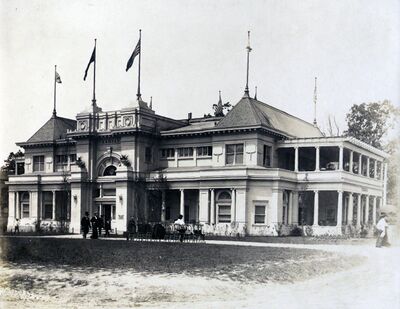Kansas
 | |
| Location | Plateau of States |
|---|---|
| Construction | |
| Construction Cost | $29,745 ($897,087 in 2021) |
| Architecture | |
| Architect | W. W. Rose, of Kansas City |
| Dimensions | 84' x 128' |
Kansas' structure was one of the prettiest pavilions on the grounds. The building had a fine location on the Plateau of States at the junction of three avenues.
Description[edit | edit source]
Two stories high, it contained a large central hall on the first floor. There were three grand entrances that opened into the central portion of the building, and with a surrounding gallery, lifts its ceiling to the vaulted roof.
In the arched windows of cathedral glass, was the coat-of-arms of the State. The floor mosaic at the main entrance is the great sunflower of the State. The same flower decorates the great frames about the pictures there.
This central area contained a Conover grand piano, and opened a succession of reception and smoking rooms and private offices.
To the rear, three large, airy rooms housed a day nursery and an emergency hospital, complete with a physician. A broad porch opens from the playroom and the older children have the use of this in pleasant weather.
Of all the State buildings facing on Commonwealth Avenue, none was more home-like or more popular than that of Kansas.
Other rooms included: a large central reception hall, post-office and check room and the spacious offices of the Commission.
The second floor featured a very large gallery of paintings by Kansas artists which included media work of oils, watercolors, pen and ink, drawings and charcoal. A.E. Albright's work was displayed in the state building as well as chosen to be represented in the Palace of Fine Arts.
All in all, there was works of art in the state building, which included: Sculpture, paintings in oil, paintings in water colors, pastels and other drawings, miniatures, etchings, paintings on china, art needlework, embroideries, etc., tapestries, etc.
All the Plateau of States colony came to hear the youthful twin prodigies from the blind school at Kansas City, Kansas, a few days ago, one of whom performed on the instrument while the other played the violin.
Kansas made exhibits in the Agriculture, Horticulture ( fruits, especially apples, peaches, plums, grapes, cherries), Education (work from 104 cities and about 400 country districts.), Mines (lead, zinc, coal, salt, gypsum, stone, shale for manufacture of brick, cement, etc.,), and Social Economy buildings.
The state had a huge exhibit of live stock of horses, cattle, swine, sheep, and poultry.
In the Palace of Agriculture, one exhibit included: at the north entrance stood a pyramid of native grasses, upon which was a vase made of oat heads, 7 feet high. Directly opposite stood a pyramid of tame grasses, upon which rested a vase made of the heads of grains and grasses, 7 feet high.
